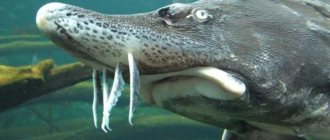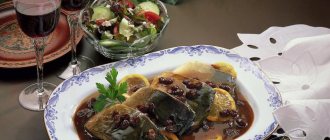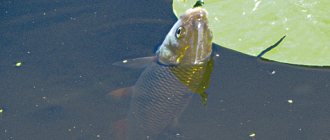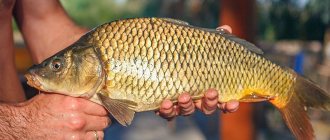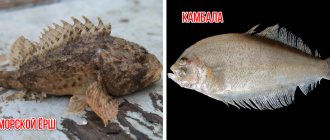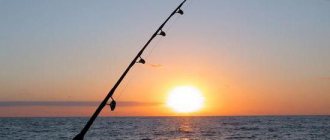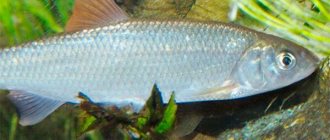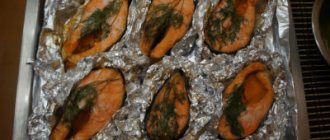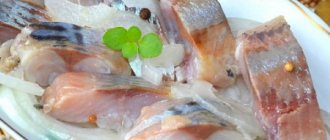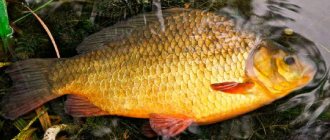This fish, if you can call it that, lives at considerable depths of the world's oceans. The appearance of this creature, since it’s simply hard to call it a fish, is so unusual that the definition immediately comes to mind as an object of extraterrestrial origin. And although this fish is not at all beautiful, its appearance is unlikely to leave indifferent anyone who managed to see this “unearthly” creature.
Where is it found?
The drop fish lives off the coast of Australia, Tasmania and New Zealand, but it is impossible for humans to meet it in nature. The depth of its habitat is 600-1200 meters, and scuba diving at 40-50 m is already considered deep-sea. Record diving, which required special equipment, the selection of special gas mixtures and many hours of ascent, allowed a person with scuba gear to reach a depth of 332 m. This was done by the Egyptian Ahmed Gabr in 2014.
The worlds of humans and deep-sea fish do not intersect: we cannot live at the pressure native to the drop fish, and she cannot live at ours. The sudden pressure drop when bringing the fish to the surface kills it and significantly changes its appearance.
The Australian goby needs cold water, 6-7 degrees Celsius. They need the seabed to reproduce and feed. These conditions limit the habitat of psychrolutes, and warming of the world's oceans may threaten the survival of the species.
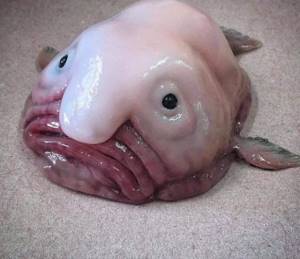
Unlike other cold-loving bottom predators - flounder and halibut - the psycholute does not lie on the bottom, but floats in the water column, so its body has not deformed. But these species compete little with each other; their feeding methods are somewhat different. They dig through the silt and extract crustaceans and mollusks that live in its depth. The food of drop fish is free-swimming crustaceans.
Flounder live in much shallower waters, going down to only 55 meters. Halibuts are deeper-sea, they live and breed at a depth of 300-1200 meters.
History of discovery
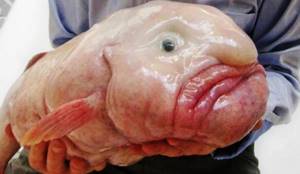
The drop fish is quite large in size and weight
The drop fish was first caught near the island of Tasmania by Australian fishermen in 1926. The caught specimen aroused great interest among them, so the find was passed on to scientists. After this, the creature was classified and forgotten for some time. This is due to the fact that it lives at a considerable depth (more than 500 m), that is, it was impossible to study marine inhabitants in natural conditions until the second half of the 20th century, when deep-sea vessels appeared.
Before this, a strange monster was found on the shores of Indonesia and Australia. But these were dead, half-decomposed specimens, so official science did not react to them in any way. Everything has changed thanks to technological progress and mechanical fishing trawlers capable of hauling nets at great depths. It was thanks to them that the first living specimen was caught.
Related species
The Australian goby is not alone; there are 10 more species in the psycholute family to which it belongs. These are all deep-sea fish that prefer to live in cold waters. This habit gave the family its name: from Greek “psychros” is translated as “cold”. Their common features are a poorly developed pelvic fin and a bare, scaleless body. Other representatives of the psycholute family are found in the Atlantic and Pacific oceans, both in the southern and northern parts, avoiding the equatorial and tropical zones. They live, depending on the species, at depths from 150 to 1000 m.
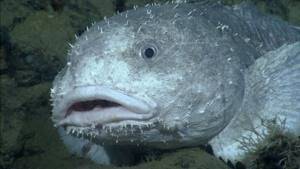
Appearance
The caught creature looks like a brown or pink droplet without scales, consisting of jelly. Body length rarely exceeds 30 cm, weight up to 2 kg.
The head is in the shape of a flattened ball; from the head to the tail the body narrows, forming a drop. The eyes are small and widely spaced.
There is no swim bladder: at great depths it is ineffective; gas from it would escape due to the high environmental pressure. Therefore, the function of the bubble is performed by the entire body of the psycholute. The gelatinous mass of which it consists is slightly lighter than water, and this allows the fish to move without expending energy. This adaptation allows the fish to exist in conditions of high pressure and small amounts of food.
If you suddenly release the pressure on a liquid, it will expand. In physics lessons we were told that liquids are incompressible. This is not entirely true. They compress, just weaker than gases, but stronger than solids. And, once in conditions of normal pressure, they acquire the same volume. At its native depth, the droplet fish is subject to pressure of 60-120 atmospheres. That’s why she looks much more graceful there and doesn’t have such a sad face at all.
A change in pressure will not change the length of the fish, but the soft tissues will certainly be deformed. This is how the “nose” and other amorphous features arise. By the way, one of the first specimens caught and studied, named “Mr. Blobby”, depicted in the most famous photo of the blob fish, lost its “nose” after being fixed in formaldehyde. This substance not only preserves biological tissues, but also dehydrates them. As a result, the specimen, as seen in another photo of it, looks a little more like an ordinary fish.
Underwater, a living psychrolut is not at all like the description of a dull fish. He resembles an ordinary bull. His face has nothing in common with the sad appearance we are used to. His mouth is really large, with thick lips (although not as thick as we are used to seeing in pictures). The drop fish has an almost complete set of fins: pectoral, dorsal, anal and caudal. It is difficult to notice them in caught fish, but they are there. If a drop of fish lived in the upper layers of water, it could be seen swimming quickly, but in deep conditions, with the help of fins, the psychrolute can rather maintain its position than purposefully move somewhere. The pelvic fin is poorly developed, the first and second dorsal fins are fused together.
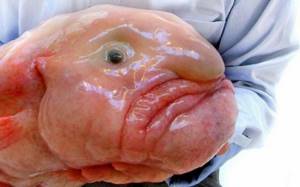
Description of fish drop
The drop fish is an inhabitant of the deep sea that leads a bottom-dwelling lifestyle . Belongs to the psycholute family and is considered one of the most incredible creatures living on Earth. Her appearance seems so repulsive to people that many of them consider the drop to be the most disgusting of the creatures living in the ocean.
Appearance

With the shape of its body, this animal really resembles a drop, and its “fluid”, gelatinous structure also corresponds to this name. If you look at it from the side or behind, it may seem that this is an ordinary, unremarkable fish of a dull, most often brownish, and sometimes dull pink color. It has a short body, tapering towards the end, and its tail is equipped with small outgrowths, vaguely similar to spikes.
But everything changes if you look at the drop’s “face”: when you see its flabby, dissatisfied and sad face, which makes this creature look like an elderly grumpy gentleman, whom someone also offended, you can’t help but wonder what other surprises there are nature can present to people, creating animals with such a truly unique and unforgettable appearance.
This is interesting! The drop does not have a swim bladder, because it would simply burst at the depth where it lives. The water pressure there is so great that the drops have to do without this “attribute”, which is common for representatives of their class.
Like most other deep-sea fish, the drop has a large, massive head, a huge mouth with thick, fleshy lips that goes into a short body, small dark, deep-set eyes and a “signature” growth on the face, reminiscent of a large, slightly flattened human nose . Because of this external feature, it was nicknamed the sad fish.
The drop fish rarely grows more than fifty centimeters in length, and its weight does not exceed 10-12 kilograms, which is very small by the standards of its habitat: after all, in the depths of the sea there are monsters that reach several meters in length. Its color, as a rule, is brownish or, less commonly, pinkish. But, in any case, the color is always dull, which helps the drop to camouflage itself with the color of bottom sediments and, ultimately, makes its existence noticeably easier.
The body of this fish is devoid of not only scales, but also muscles, which is why the density of the drop is similar to frozen and jellied jellied meat lying on a plate .
The gelatinous substance is produced by a special air bladder that these animals are equipped with. The lack of scales and muscular system are advantages, not disadvantages of drop fish. Thanks to these features, she does not need to expend effort when moving at great depths. And it’s easier to eat this way: you just need to open your mouth and wait until something edible swims in.
What does it eat?
The Australian goby is a predator, unlike most benthic inhabitants that feed on carrion. The main part of the diet of drop fish is small marine invertebrates drifting in the bottom areas. This fish is a passive hunter; it does not swim after prey, but stays in one place. Australian gobies eat the plankton that floats into their mouths.
An important problem with psychrolutes is that at depth there is not as much life, and therefore food, as in the upper layers of the ocean. The fish itself is not very well adapted to moving long distances for food, which means that if it is unlucky, it may be in danger of starvation.
But a caring mom
Drop fish grow to about 30 cm. Females lay thousands of small, touchingly pink eggs on the sea during the day.
And then they carefully sit on them to protect them from predators. In this case, females are sometimes replaced by males. In general, it is not clear how such beauties find a mate, and indeed find the strength to reproduce. They do not even have a swim bladder - an air sac found in most fish, which allows them to stay in the water and move around.
We also recommend reading:
Top 7 dogs that are great for children Stubborn nature: dogs that are difficult to train Ways to eliminate malocclusion in puppies Pet: why a dog refuses to go for walks
Interesting! It is believed that at their usual depth these fish are more active and have more abilities. And they look better! And on the surface, when they are caught and lifted from the bottom, they literally melt and spread into a sticky puddle. The reason for this strangeness is the difference in pressure.
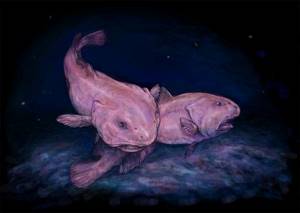
Character and lifestyle
Having practically no muscles, a drop of fish in the water can either not move at all, or drift with bottom currents. Her vision is adapted to her habitat: although the photometer records the sun's rays to a depth of 1,000 meters, the human eye can no longer distinguish light below 600 m; everything around us would seem equally black. And the drop fish manages to navigate in such conditions with the help of vision. In natural conditions, her eyes look completely different from those in terrestrial photographs. They protrude above the surface of the head and protrude slightly forward.
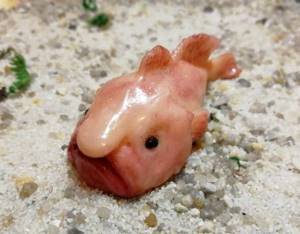
Fancy shape
At first glance, it is difficult to mistake this miracle of nature for a fish. The body raised to the surface not only does not have the characteristic fish shape, but even any shape at all. But in a natural aquatic environment, it really resembles a drop tapered to its tail, which is why it got its name. The body is completely smooth on top and has no scales at all. These oddities are explained by the deep-sea habitat (600-1200m). To withstand the colossal pressure of water, the inhabitants of such depths have to evolve.
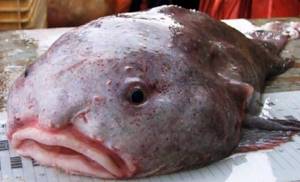
Reproduction and lifespan
Representatives of this species live 5-14 years, on average 8-9. Little is known about how psychrolutes reproduce: the great depth makes it difficult to observe the fish. Therefore, we do not know what their mating rituals are, how the choice of a partner and mating itself occur. However, it turned out that one thing can be learned: drop fish are caring mothers. They lay eggs in the sand, and then protect the clutch and hatched larvae until they turn into full-fledged fry and are able to escape from predators themselves.
The protection of clutches is often found in deep-sea fish, but care for the hatched offspring is not particularly characteristic even for them. An interesting feature is that the Australian goby takes its droplet-like larvae immediately after hatching to even greater depths, to the quietest places possible. This minimizes the likelihood of early encounters between offspring and predators or scavengers, who, on occasion, will not refuse to snack on the fry.
Even such a device, which provides the brood with maximum survival, cannot significantly accelerate the growth rate of the drop fish population. With the same care of females for their cubs, to double the population in the event of a complete cessation of human intervention in the life of psychrolutes, it will take from 4.5 to 14 years for the number of representatives of the species to double. This is a long time for such a process.
Living conditions
So far, only residents of Asia consider the drop fish edible and even a delicacy; they call it the “king fish,” but it is not commercially available. In other places on the planet they are indifferent to it and are in no hurry to eat it, because they believe that there is nothing to eat in it. There are no muscles, which means there is nothing to fry or stew - just solid jelly.
In local markets you can see drop fish, which are even sold as a souvenir to sailors or for owners of Asian restaurants, where they are very expensive, like high-quality tuna.
According to scientists, adult blob fish lead a solitary lifestyle and find a mate only for procreation. Having once chosen a territory of a couple of meters around the perimeter, the fish almost never leaves it and does not rise above 600 m of depth. That is, in artificial conditions, of course, this species will not survive.
Due to the fact that the drop fish cannot move quickly, it has to feed on what swims into its mouth. She waits for her prey lying on the bottom or drifting in a slight elevation, with her mouth wide open. Basically, it turns out to swallow plankton, but if it comes across invertebrates or any other edible organisms of a suitable size, it does not disdain them.
What comes down from above also does not go unnoticed. It is known that the drop fish cannot endure hunger for a long time and, in the absence or minimum of it, can die, since the fish itself will never be able to catch up with the “food” even with a strong desire.
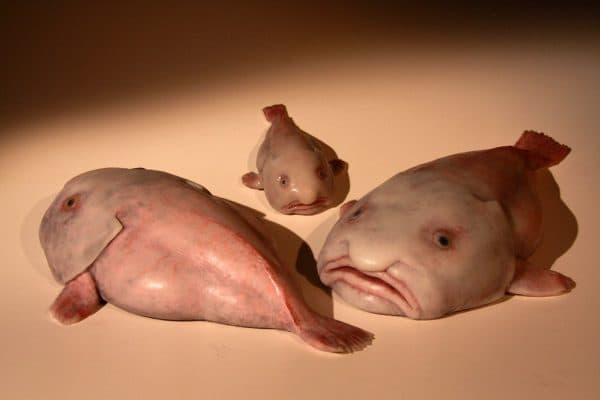
Amazing fish can live up to 14 years, but their lifespan depends primarily on luck, and not on their “neighbors” in depth or living conditions.
Few of the blob fish die of hunger, mostly they have enough food at the bottom, but if they die from fishing nets or are hunted, there is a high probability that they will not live to old age.
A decline in the population of the species is also caused by sunken oil tankers migrating throughout the ocean and collecting tons of unprocessed household waste in huge garbage islands, destroying all life on and under the water, including settling to the bottom.
Main Enemies
According to modern scientists, the Australian bull has no natural enemies. Theoretically, these could include deep-sea squid, angler fish and other predatory inhabitants of the seabed, but whether this is so, as well as what tactics the psychrolute uses to protect itself from predators, is not known for certain. But it is clear that the population of these inhabitants of the depths is rapidly declining. This is due to humans, or more precisely, to the bottom fishing of marine crustaceans - lobsters and crabs. Along with the delicacy, a strange, sedentary fish also ends up in the net. Thus, a person casually destroys a species that is edible only conditionally and has no other economic value: after trawling, there is no point in releasing fish into the sea that have received injuries incompatible with life due to a rapid change in pressure. Even if it is alive at the time of catching, death after such exposure is inevitable.
Many people wonder if drops eat fish?
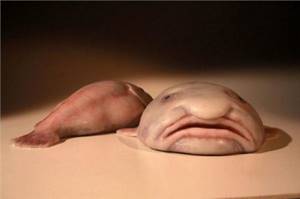
In most European countries, the blob fish is considered unfit to eat because it has no nutrients, not to mention its repulsive appearance. However, residents of China and Japan consider the meat of this fish to be a delicacy and prepare various dishes from it. This species is endangered and not only because of the love of its meat by the inhabitants of Central Asia, but also for a number of other reasons
This species is not intentionally caught, however, during deep-sea commercial fishing for crabs and lobsters, a drop of fish ends up in nets. This is explained by the fact that she has underdeveloped muscles, which does not allow her to quickly dodge trawling (bottom fishing). It also happens that during strong storms this fish is washed ashore by waves.
Many promotional campaigns are being thought out to at least slightly reduce the sharp decline in population numbers. Most people from different countries supported this idea and joined in supporting the conservation of this species. But, unfortunately, it is impossible to keep it in artificial conditions and therefore we learn about it from various sources, photos and videos.
Time does not stand still and perhaps soon a way will be found to preserve the extinction of this species. And nowadays, the drop fish, thanks to its simple appearance, is very popular. She is used as an Internet character for various jokes and parodies.
Edible or not
The fish is not poisonous, in principle you can eat it, but it has practically no muscles: the body consists mainly of a jelly-like fat mass. It is served only in establishments for exotic lovers. Dishes made from it are expensive, but what is valuable in them is not the nutrients, but the fact of eating such an unusual creature. Chefs prefer to keep recipes for exotic dishes secret. Europeans almost never eat “gelatinous” fish.
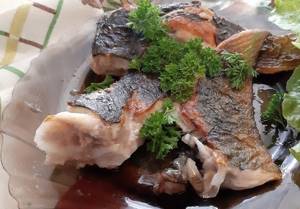
Security status
Ecologists do not know how much the Australian goby needs protection. Scientists have not been able to calculate how many of these fish now live in the World Ocean, since deep-sea inhabitants are extremely difficult to study. But the genetic diversity of the caught individuals turned out to be small, which means that there is inbreeding within the species. This leads oceanologists to believe that the species is already rare, and threats from trawl fishing for crustaceans off the coast of Australia and New Zealand, as well as warming of the world's oceans, can lead to the fact that the drop fish will remain only in photographs.
You shouldn’t scour the Internet looking for recipes for drop fish dishes. For Europeans it is too exotic, for nature lovers it is rare. It’s also difficult to admire this sea creature - he may be cute, but he’s not handsome. Therefore, the best thing humanity can do for the Australian bull is not to touch it. He made his contribution to art, ecology and even the meme, and deserved to be left alone.
Eating
Despite the fact that in many countries the Drop is considered an inedible sea creature, in Japan and some Asian places it is considered a real delicacy.
Some dishes are prepared from Australian carp, the cost of which increases several times in comparison with ordinary and traditional delicacies. It is known that fish fillet contains a lot of macroelements and nutrients that have a beneficial effect on the functioning of the body.
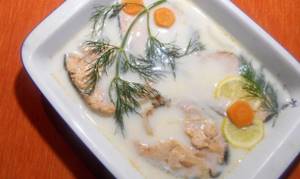
Important!
Despite this, in many developed countries this species is considered inedible and unattractive for cooking.
Interesting Facts
The drop fish was first caught almost 100 years ago, in 1926. She accidentally fell into the nets of Tasmanian fishermen. Then the unusual find was described, the species was given a name, and the study stopped there. Only at the end of the 20th century did psycholute again attract the attention of researchers: thanks to the development of technology, the study of deep-sea fish became somewhat easier.
The unusual appearance of the drop fish has repeatedly attracted the attention of film directors. It appears in The X-Files (episode "Rm9sbG93ZXJz", season 11, episode 7), where it is served to Mulder uncut in a robotic sushi bar. In the film “Men in Black 3,” the chef presented this creature as earthly, but no one believed him: the gelatinous creature with a sad, human-like face bears little resemblance to ordinary representatives of our fauna.
Internet users have repeatedly voted the Australian bull the ugliest animal on the planet. She even won over pubic lice, and since 2013 has been featured on the emblem of the Ugly Animals Conservation Society.
The blobfish, the Australian goby or psychrolute (from the scientific name Psychrolutes marcidus), has become widely known as the hero of Internet memes. This is the saddest fish in the world, whose comical but cute appearance is complemented by a drooping “nose”. With the expression of its muzzle and the general amorphousness of its body, this sea creature resembles another hero of the meme, Zhdun. But, unlike him, the drop fish is a real inhabitant of our planet, which is also in danger of complete extinction.
Exhibit in the museum
The very first specimen was discovered in 2003. The fish was spotted and caught off the coast of New Zealand. Fishermen and scientists were very amazed by their unusual find. She was immediately photographed and then sent to the Australian Museum. There it is stored to this day, in a 70% alcohol solution.
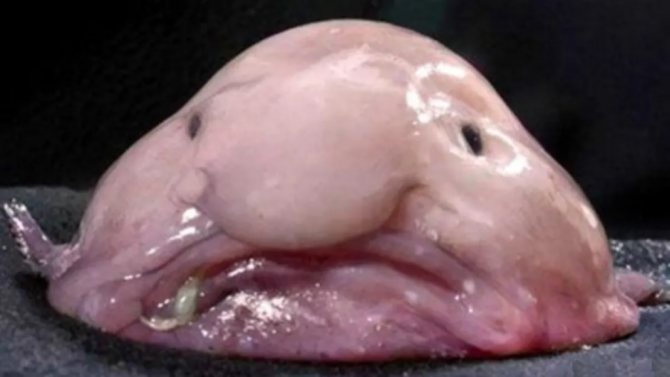
They just say that during storage in alcohol, the cute nose of the fish decreased. That's why she doesn't look so funny now. The individual has actually evolved significantly, scientists believe.
After all, there is not much food in deep water, so she needed to somehow conserve her energy and not starve. The fish spends most of its time “resting” and lazing around. When something edible appears nearby, it opens its mouth and makes minimal movements towards the food. Just some kind of hunter and predator of the year!
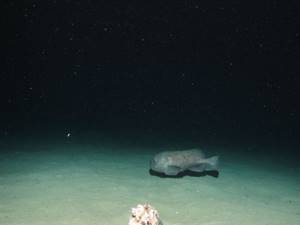
By the way, about predators. Most likely, the only threat to the creature is people. In some countries, the meat of this individual is even considered a delicacy. Would you eat such a delicious thing?
